 Published in 2013 by The Rosen Publishing Group, Inc. 29 East 21st Street, New York, NY 10010 Copyright 2013 by The Rosen Publishing Group, Inc. All rights reserved. No part of this book may be reproduced in any form without permission in writing from the publisher, except by a reviewer. First Edition Editor: Joanne Randolph Book Design: Greg Tucker Photo Credits: BananaStock/Thinkstock. Library of Congress Cataloging-in-Publication Data Mahaney, Ian F.
Published in 2013 by The Rosen Publishing Group, Inc. 29 East 21st Street, New York, NY 10010 Copyright 2013 by The Rosen Publishing Group, Inc. All rights reserved. No part of this book may be reproduced in any form without permission in writing from the publisher, except by a reviewer. First Edition Editor: Joanne Randolph Book Design: Greg Tucker Photo Credits: BananaStock/Thinkstock. Library of Congress Cataloging-in-Publication Data Mahaney, Ian F.
Math at the bank: place value and properties of operations / by Ian F. Mahaney. 1st ed. p. cm. (Core math skills) Includes index.
ISBN 978-1-4488-9655-4 (library binding) ISBN 978-1-4488-9768-1 (pbk.) ISBN 978-1-4488-9769-8 (6-pack) 1. MultiplicationJuvenile literature. 2. AdditionJuvenile literature. 3. 4. 4.
Place value (Mathematics)Juvenile literature. 5. Banks and bankingMathematicsJuvenile literature. I. Title. QA115.M2274 2013 513.21dc23 2012024517 Manufactured in the United States of America CPSIA Compliance Information: Batch #W13PK4: For Further Information contact Rosen Publishing, New York, New York at 1-800-237-9932 Contents Math Is Everywhere Sometimes when you are using math, it may not be obvious right away, such as when you are in the kitchen.
At the bank, though, you can see the relationship to math right away. are the ones, tens, and hundreds. The math operations addition, subtraction, multiplication, and division are important at banks, too. If a has five $20 bills, she can write a math sentence to find the total: 5 x $20 = $100. This book is about place value and the properties of operations used at a bank. 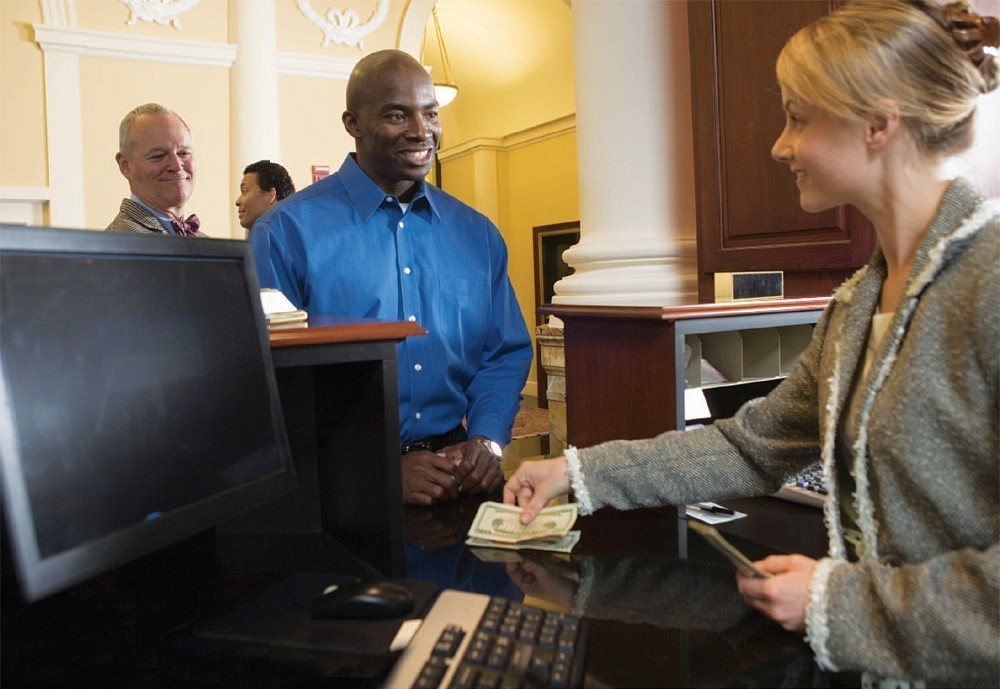 If a customer wants to take out $60, the teller can count out six $10 bills: 6 x $10 = $60.
If a customer wants to take out $60, the teller can count out six $10 bills: 6 x $10 = $60.
She could also count out three $20 bills: 3 x $20 = $60. If a bank teller has six $100 bills, how much money does he have? (See answers on p. ) Figure It Out Ones, Tens, and More By looking at the ones, tens, and hundreds digits, place value allows you to understand how large a number is. It also helps you compare two numbers to figure out which one is bigger. You can use place value to compare 2,996 and 2,922. Each number has two thousands, so next compare the value of digits to the right of the thousands.
Each number has nine hundreds, but the tens digit offers the solution. There are nine tens in 2,996 and two tens in 2,922. The greater number is 2,996, and that is expressed as 2,996 > 2,922. It helps to break down the digits to see the place value.
| Thousands | Hundreds | Tens | Ones |
| | | |
| | | |
A chart like this one makes it easy to see the place values in a number.

Our number system is based on the number 10.
Every digit is 10 times greater than the digit to its right. The system is called base 10. Is 3,582 or 3,528 larger? Make a chart like the on p. to solve this. (See answers on p. ) Figure It Out Opening an Account The first time many people use a bank is when they open an in the bank.
If you open a savings account with a $5 bill and a $20 bill, you deposit $5 + $20 = $25. Another way to express this is with place value. It would look like this: $20 is two tens and $5 is five ones for a total of $20 + $5 = $25.  Has your teacher ever talked about turn-around facts? She is talking about the commutative property. . It says you can switch the order of two numbers you are adding or multiplying.
Has your teacher ever talked about turn-around facts? She is talking about the commutative property. . It says you can switch the order of two numbers you are adding or multiplying.
The commutative property says that $5 + $20 = $20 + $5 = $25.  If you open a savings account with 5 $10 bills, how much do you have in the account? How much is in an account you open with 10 $5 bills? (See answers on p. ) Figure It Out More or Less? Daniel and Kristen do chores for an . Daniel saved $10 each week for 12 weeks. That is 12 x $10 = $120. Kristen saved $12 for 10 weeks.
If you open a savings account with 5 $10 bills, how much do you have in the account? How much is in an account you open with 10 $5 bills? (See answers on p. ) Figure It Out More or Less? Daniel and Kristen do chores for an . Daniel saved $10 each week for 12 weeks. That is 12 x $10 = $120. Kristen saved $12 for 10 weeks.
That is 10 x $12 = $120. Remember the commutative property says you are allowed to swap the numbers in a multiplication problem. Sorted for place value, 120 has one hundred, two tens, and zero ones:
Anne has saved $160 from babysitting.
To find out who of the three is going to deposit the most money, analyze the place value. All three have one hundred, but Anne has more tens.

Bobby has $50 he earned from shoveling snow.

Bobby has $50 he earned from shoveling snow.
If he adds that to $315 he has in his savings account, how much money does he have in the bank? What are the hundreds, tens, and ones values? (See answers on p. ) Figure It Out Make a Deposit David has a paper route. He earns $47 in February, $50 in March, and $43 in April. Then he deposits the checks the newspaper company sent him. David fills out a of addition and multiplication tells you that when adding or multiplying three or more numbers, you can do it in any order. For David, this means he can add $47 and $50 together and then add $43.
He can also rearrange the numbers and add $47 and $43 first and add $50 to that: $47 + $43 + $50 = $90 + $50 = $140. 
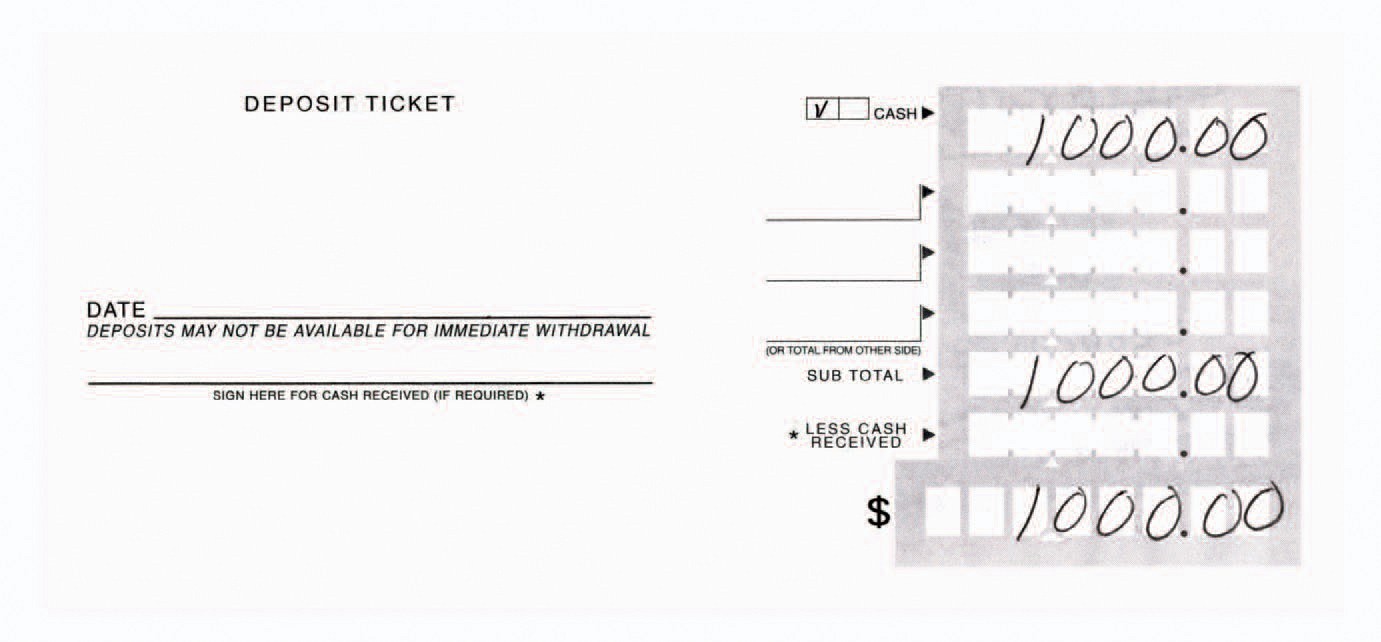 When you fill in a deposit slip, or ticket, you are using place value. The numbers to the right of the dot are cents. On the left side, the first box to the left of the dot is the ones place, the second box is the tens, and so on. For three days, a bank is giving $7 to the first seven people who open savings accounts. ) Figure It Out What to Do with Change? You can split $1 into parts, or cents. ) Figure It Out What to Do with Change? You can split $1 into parts, or cents.
When you fill in a deposit slip, or ticket, you are using place value. The numbers to the right of the dot are cents. On the left side, the first box to the left of the dot is the ones place, the second box is the tens, and so on. For three days, a bank is giving $7 to the first seven people who open savings accounts. ) Figure It Out What to Do with Change? You can split $1 into parts, or cents. ) Figure It Out What to Do with Change? You can split $1 into parts, or cents.
The coins you may keep in a piggy bank can add up to dollars. Have you seen money written as a , like $2.14? The 2 is in the ones column. The period is the decimal point. It tells you that every digit to the right is part of a dollar. The 1 is in the tenths position and equals one dime. The 4 is in the hundredths position and equals four pennies.
Do you see that digits to the right of the decimal point follow place value rules, too? One dollar is 10 times greater than the digit to its right, the tenths digit. 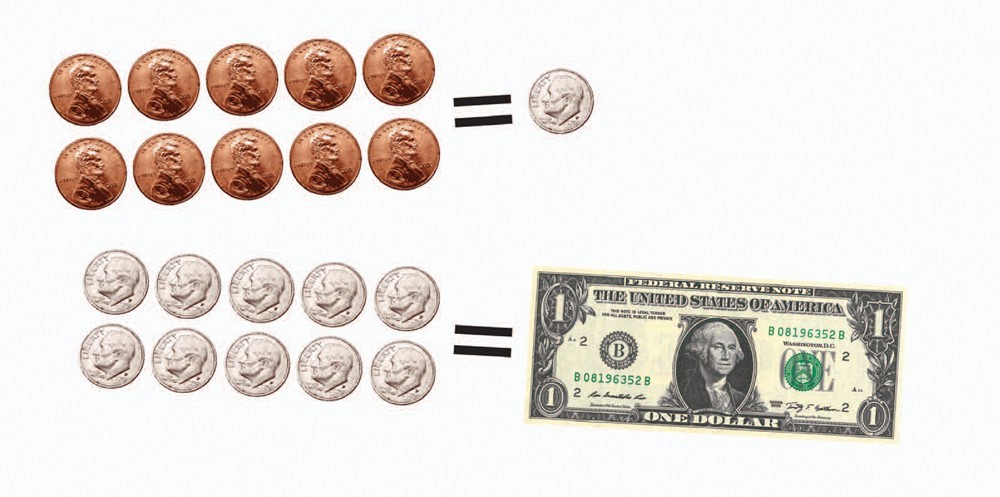
Next page
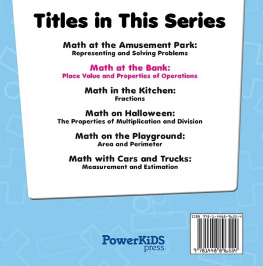
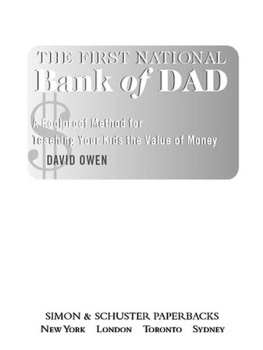


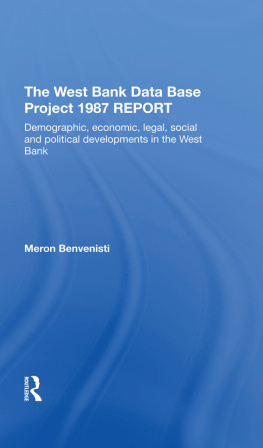
 Published in 2013 by The Rosen Publishing Group, Inc. 29 East 21st Street, New York, NY 10010 Copyright 2013 by The Rosen Publishing Group, Inc. All rights reserved. No part of this book may be reproduced in any form without permission in writing from the publisher, except by a reviewer. First Edition Editor: Joanne Randolph Book Design: Greg Tucker Photo Credits: BananaStock/Thinkstock. Library of Congress Cataloging-in-Publication Data Mahaney, Ian F.
Published in 2013 by The Rosen Publishing Group, Inc. 29 East 21st Street, New York, NY 10010 Copyright 2013 by The Rosen Publishing Group, Inc. All rights reserved. No part of this book may be reproduced in any form without permission in writing from the publisher, except by a reviewer. First Edition Editor: Joanne Randolph Book Design: Greg Tucker Photo Credits: BananaStock/Thinkstock. Library of Congress Cataloging-in-Publication Data Mahaney, Ian F. If a customer wants to take out $60, the teller can count out six $10 bills: 6 x $10 = $60.
If a customer wants to take out $60, the teller can count out six $10 bills: 6 x $10 = $60. Our number system is based on the number 10.
Our number system is based on the number 10.  Has your teacher ever talked about turn-around facts? She is talking about the commutative property. . It says you can switch the order of two numbers you are adding or multiplying.
Has your teacher ever talked about turn-around facts? She is talking about the commutative property. . It says you can switch the order of two numbers you are adding or multiplying. If you open a savings account with 5 $10 bills, how much do you have in the account? How much is in an account you open with 10 $5 bills? (See answers on p. ) Figure It Out More or Less? Daniel and Kristen do chores for an . Daniel saved $10 each week for 12 weeks. That is 12 x $10 = $120. Kristen saved $12 for 10 weeks.
If you open a savings account with 5 $10 bills, how much do you have in the account? How much is in an account you open with 10 $5 bills? (See answers on p. ) Figure It Out More or Less? Daniel and Kristen do chores for an . Daniel saved $10 each week for 12 weeks. That is 12 x $10 = $120. Kristen saved $12 for 10 weeks. Bobby has $50 he earned from shoveling snow.
Bobby has $50 he earned from shoveling snow. 
 When you fill in a deposit slip, or ticket, you are using place value. The numbers to the right of the dot are cents. On the left side, the first box to the left of the dot is the ones place, the second box is the tens, and so on. For three days, a bank is giving $7 to the first seven people who open savings accounts. ) Figure It Out What to Do with Change? You can split $1 into parts, or cents. ) Figure It Out What to Do with Change? You can split $1 into parts, or cents.
When you fill in a deposit slip, or ticket, you are using place value. The numbers to the right of the dot are cents. On the left side, the first box to the left of the dot is the ones place, the second box is the tens, and so on. For three days, a bank is giving $7 to the first seven people who open savings accounts. ) Figure It Out What to Do with Change? You can split $1 into parts, or cents. ) Figure It Out What to Do with Change? You can split $1 into parts, or cents.